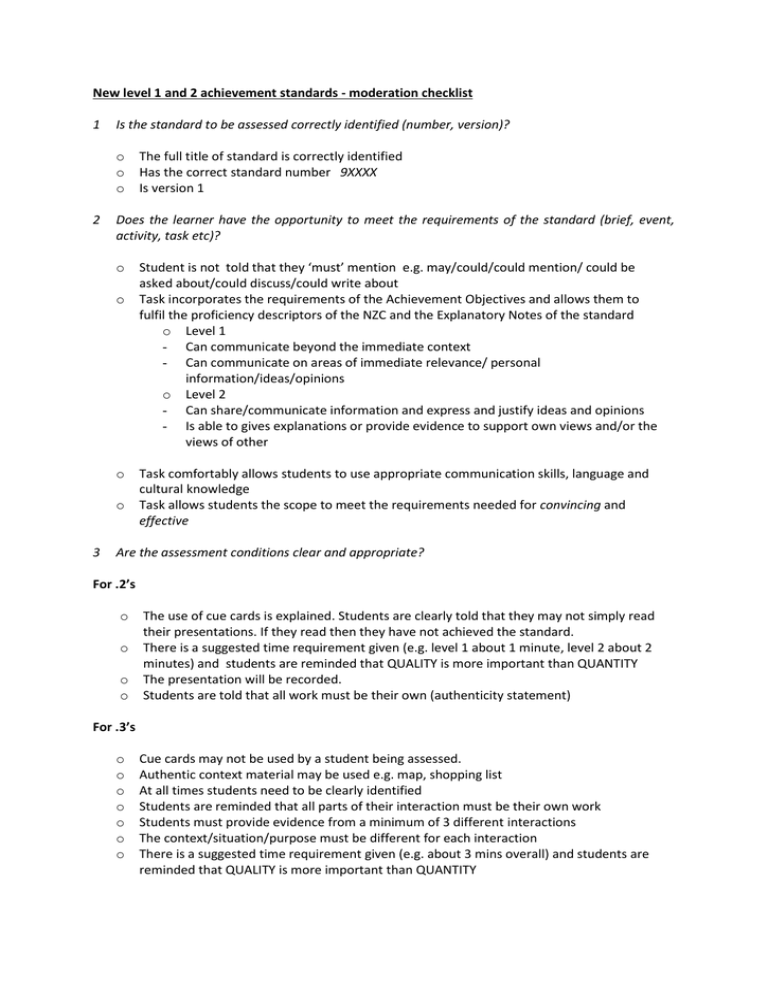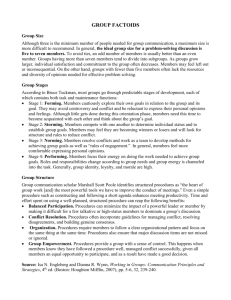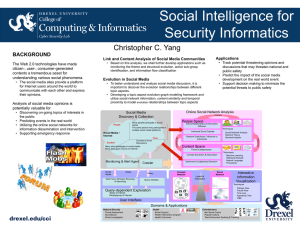Word (DOCX, 18KB)
advertisement

New level 1 and 2 achievement standards - moderation checklist 1 Is the standard to be assessed correctly identified (number, version)? o o o 2 Does the learner have the opportunity to meet the requirements of the standard (brief, event, activity, task etc)? o o o o 3 The full title of standard is correctly identified Has the correct standard number 9XXXX Is version 1 Student is not told that they ‘must’ mention e.g. may/could/could mention/ could be asked about/could discuss/could write about Task incorporates the requirements of the Achievement Objectives and allows them to fulfil the proficiency descriptors of the NZC and the Explanatory Notes of the standard o Level 1 - Can communicate beyond the immediate context - Can communicate on areas of immediate relevance/ personal information/ideas/opinions o Level 2 - Can share/communicate information and express and justify ideas and opinions - Is able to gives explanations or provide evidence to support own views and/or the views of other Task comfortably allows students to use appropriate communication skills, language and cultural knowledge Task allows students the scope to meet the requirements needed for convincing and effective Are the assessment conditions clear and appropriate? For .2’s o o o o The use of cue cards is explained. Students are clearly told that they may not simply read their presentations. If they read then they have not achieved the standard. There is a suggested time requirement given (e.g. level 1 about 1 minute, level 2 about 2 minutes) and students are reminded that QUALITY is more important than QUANTITY The presentation will be recorded. Students are told that all work must be their own (authenticity statement) For .3’s o o o o o o o Cue cards may not be used by a student being assessed. Authentic context material may be used e.g. map, shopping list At all times students need to be clearly identified Students are reminded that all parts of their interaction must be their own work Students must provide evidence from a minimum of 3 different interactions The context/situation/purpose must be different for each interaction There is a suggested time requirement given (e.g. about 3 mins overall) and students are reminded that QUALITY is more important than QUANTITY For .5’s o o o 4 Are there statements provided that give examples of learner responses which meet the requirements of the standard (evidence statements)? o o o o 5 Students are told all work must be their own (authenticity statement) Teachers give a suggested word/character/ kana requirement (e.g. level 1 -300 words/characters and 600 kana overall, level 2 - 400 words/characters and 800 kana) and are told that QUALITY is more important than QUANTITY 3 different text types/purposes/situations must be submitted Students are told that they may not use the language examples in their own work unless they have been significantly manipulated to show that they are their own. The language examples exemplify the curriculum level (level 1 - beyond the immediate context, level 2 – expressing and justifying information, ideas and opinions) The language samples exemplify personal information/ideas/opinions. The Merit sample will exemplify ‘convincing’ and the Excellence sample ‘effective’ (see clarifications docs for features of these criteria) Are there statements provided that clearly describe performance levels (quality and quantity) which meet the requirements of the standard (judgement statements)? o o o The assessment schedule for the presetnations is personalised (not just generic) to suit the task at A, M and E. e.g. A clear spoken presentation is given in target language about a visit to the target language country. The assessment schedule is given to the student in advance and is the right version and level. The assessment criteria accurately reflect the standard


